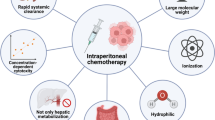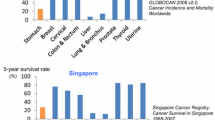Abstract
Purpose
We studied the efficacy and safety of intraperitoneal chemotherapy with hydroxycamptothecin (HCPT) for the treatment of peritoneal carcinomatosis in animal model.
Methods
Highly metastatic human hepatocellular carcinoma (HCC) cell line HCCLM3 was injected into the peritoneal cavity of 30 nude mice to construct a model of intraperitoneal carcinomatosis, which were randomized into a treatment group and a control group of 15 mice in each group. The former received intraperitoneal injections of HCPT at the dose of 2 mg/kg body weight for 7 days every other week, on weeks 2, 4 and 6; and the latter received the same dose schedule treatment of 0.9% sodium chloride solution. The mice were observed for 8 weeks. Body weight changes, intraperitoneal carcinomatosis, hematological and biochemical parameters were evaluated.
Results
On day 56, 14 mice in the treatment group were still alive, compared against 5 in the control group, and the mean survival time was 55 ± 1 days [95% confidence interval (CI) 54–57 days] versus 43 ± 4 days (95% CI 34–51 days) (P = 0.002). The tumor weight in the treatment group (0.8 ± 0.8 g) was significantly smaller than the control group (2.0 ± 0.8 g) (P = 0.00028). No bloody ascites or diffuse peritoneal carcinomatosis were observed in the treatment group, as compared with 4 mice (26.7%) that developed bloody ascites and 6 mice (40%) which developed diffuse peritoneal carcinomatosis in the control group (P < 0.001). The treatment group had a significantly lower peripheral white blood cell count [(3.18 ± 1.72) × 109 l−1] than the control group [(5.08 ± 2.03) × 109 l−1] (P < 0.05), significantly lower serum alpha fetoprotein level (101.22 ± 20.12 μg/l) than the control group (244.87 ± 30.24 μg/l) (P < 0.05), and significantly lower serum gamma glutamyl transpeptidase level (12.45 ± 2.26 U/l) than the control group (20.75 ± 3.87 U/l) (P < 0.05). No obvious treatment related toxicities were observed.
Conclusions
Intraperitoneal injection of HCPT could inhibit tumor progression, reduce the extent of peritoneal carcinomatosis and improve survival of tumor bearing mice.






Similar content being viewed by others
References
Boige V, Taieb J, Hebbar M, Malka D, Debaere T, Hannoun L, Magherini E, Mignard D, Poynard T, Ducreux M (2006) Irinotecan as first-line chemotherapy in patients with advanced hepatocellular carcinoma: a multicenter phase II study with dose adjustment according to baseline serum bilirubin level. Eur J Cancer 42:456–459
Cagol PP, Pasqual E, Bacchetti S (2003) Natural history of the neoplastic locoregional disease: clinical and pathological patterns. J Exp Clin Cancer Res 22(4 Suppl):1–4
Chen T, Chu ZH, Liu JP, Wang J, Zhao HY, Ou QJ (2005) Application of adenosine triphosphate tumor chemosensitive assay system to individual chemotherapy for hepatocellular carcinoma. Ai Zheng 24:1018–1022 (Article in Chinese with English abstracts and graphs)
Eriguchi N, Aoyagi S, Okuda K, Tamae T, Fukuda S, Kanazawa N, Hamada S, Kawabata M, Nishimura K, Kodama T (2000) Successful surgical treatment for implanted intraperitoneal metastases of hepatocellular carcinoma. J Hepatobiliary Pancreat Surg 7:520–523
Fu YR, Yi ZJ, Yan YR, Qiu ZY (2006) Hydroxycamptothecin-induced apoptosis in hepatoma SMMC-7721 cells and the role of mitochondrial pathway. Mitochondrion 6:211–217
Gornet JM, Azoulay D, Duclos-Vallee JC, Goldwasser F (2000) Complete remission of unresectable hepatocellular carcinoma on healthy liver by the combination of aggressive surgery and high-dose-intensity chemotherapy by CPT-11. Anticancer Drugs 11:649–652
Guichard S, Chatelut E, Lochon I, Bugat R, Mahjoubi M, Canal P (1998) Comparison of the pharmacokinetics and efficacy of irinotecan after administration by the intravenous versus intraperitoneal route in mice. Cancer Chemother Pharmacol 42:165–170
Kosaka A, Hayakawa H, Kusagawa M, Takahashi H, Okamura K, Mizumoto R, Katsuta K (1999) Successful surgical treatment for implanted intraperitoneal metastases of ruptured small hepatocellular carcinoma: report of a case. Surg Today 29:453–457
Li Y, Tang ZY, Ye SL, Liu BB, Liu YK, Chen J, Xue Q (2003) Establishment of a hepatocellular carcinoma cell line with unique metastatic characteristics through in vivo selection and screen for metastasis-related genes through cDNA microarray. J Cancer Res Clin Oncol 129:43–51
Ministry of Health of the People’s Republic of China. (2005) China’s Health Statistics Overview in 2005. See the website of China’s Ministry of Health at http://www.moh.gov.cn/open/statistics/digest05/s79.htm
Minsky BD, Mies C, Rich TA, Recht A, Chaffey JT (1988) Potentially curative surgery of colon cancer: patterns of failure and survival. J Clin Oncol 6:106–118
Ohashi N, Kodera Y, Nakanishi H, Yokoyama H, Fujiwara M, Koike M, Hibi K, Nakao A, Tatematsu M (2005) Efficacy of intraperitoneal chemotherapy with paclitaxel targeting peritoneal micrometastasis as revealed by GFP-tagged human gastric cancer cell lines in nude mice. Int J Oncol 27:637–644
O’Reilly EM, Stuart KE, Sanz-Altamira PM, Schwartz GK, Steger CM, Raeburn L, Kemeny NE, Kelsen DP, Saltz LB (2001) A phase II study of irinotecan in patients with advanced hepatocellular carcinoma. Cancer 91:101–105
Pelz JO, Doerfer J, Dimmler A, Hohenberger W, Meyer T (2006) Histological response of peritoneal carcinomatosis after hyperthermic intraperitoneal chemoperfusion (HIPEC) in experimental investigations. BMC Cancer 6:162
Pommier Y (2006) Topoisomerase I inhibitors: camptothecins and beyond. Nat Rev Cancer 6:789–802
Rosen LS (1998) Irinotecan in lymphoma, leukemia, and breast, pancreatic, ovarian, and small-cell lung cancers. Oncology (Williston Park) 12(8 suppl 6):103–109
Rufian S, Munoz-Casares FC, Briceno J, Diaz CJ, Rubio MJ, Ortega R, Ciria R, Morillo M, Aranda E, Muntane J, Pera C (2006) Radical surgery-peritonectomy and intraoperative intraperitoneal chemotherapy for the treatment of peritoneal carcinomatosis in recurrent or primary ovarian cancer. J Surg Oncol 94:316–324
Ryu JK, Lee SB, Kim KH, Yoh KT (2004) Surgical treatment in a patient with multiple implanted intraperitoneal metastases after resection of ruptured large hepatocellular carcinoma. Hepatogastroenterology 51:239–242
Sato M, Tokui K, Watanabe Y, Lee T, Kohtani T, Nezu K, Kawachi K, Kito K, Sugita A, Ueda N. G (1999) Generalized intraperitoneal seeding of hepatocellular carcinoma after microwave coagulation therapy: a case report. Hepatogastroenterology 46:2561–2564
Singhal P, Lele S (2006) Intraperitoneal chemotherapy for ovarian cancer: where are we now? J Natl Compr Canc Netw 4:941–946
Sugarbaker PH, Schellinx ME, Chang D, Koslowe P, von Meyerfeldt M (1996) Peritoneal carcinomatosis from adenocarcinoma of the colon. World J Surg 5:585–591
Sugarbaker PH, Yu W, Yonemura Y (2003) Gastrectomy, peritonectomy, and perioperative intraperitoneal chemotherapy: the evolution of treatment strategies for advanced gastric cancer. Semin Surg Oncol 21:233–248
Trimble EL, Alarez RD (2006) Intraperitoneal chemotherapy and the NCI clinical announcement. Gynecol Oncol 103:S18–19
Wall ME, Wani MC (1995) Camptothecin and taxol: discovery to clinic-thirteenth Bruce F. Cain Memorial Award lecture. Cancer Res 55:753–760
Ye M, Lin XX, Pan HM, Li N, Lou F, Jin W, Zheng Y,Wu JM (2005) Pharmacokinetic study of intraperitoneal chemotherapy with HCPT. Zhongguo Zhong Yao Za Zhi 30:1610–1612 (in Chinese with abstract in English)
Yonemura Y, Bandou E, Kawamura T, Endou Y, Sasaki T (2006) Quantitative prognostic indicators of peritoneal dissemination of gastric cancer. Eur J Surg Oncol 32:602–606
Yu W, Whang I, Suh I, Averbach A, Chang D, Sugarbaker PH (1998) Prospective randomized trial of early postoperative intraperitoneal chemotherapy as an adjuvant to respectable gastric cancer. Ann Surg 228:374–354
Yu W, Whang I, Chung HY, Averbach A, Sugarbaker PH (2001) Indications for early postoperative intraperitoneal chemotherapy of advanced gastric cancer: results of a prospective randomized trial. World J Surg 25:985–900
Yu ZJ, Yu JW, Cai W, Yuan HX, Li XY, Yuan Y, Chen JP, Wu XY, Yao DF (2005) Evaluation of HCPT d1, d14-bouble passaged intervening chemotherapy protocol for hepatocellular carcinoma. World J Gastroenterol 11:5221–5225
Zhang XW, Xu B (2000) Differential regulation of P53, c-Myc, Bcl-2, Bax and AFP protein expression, and caspase activity during 10-hydroxycamptothecin-induced apoptosis in Hep G2 cells. Anticancer Drugs 11:747–756
Zhang XW, Qing C, Xu B (1999) Apoptosis induction and cell cycle perturbation in human hepatoma hep G2 cells by 10-hydroxycamptothecin. Anticancer Drugs 10:569–576
Zhang XW, Zhou Y, Xu B (2000) Differentiation of human hepatoma Hep G2 cells induced by 10-hydroxycamptothecin. Chin Med J 113:712–713
Author information
Authors and Affiliations
Corresponding author
Additional information
Supported by New-Century Excellent Talents Supporting Program of the Ministry of Education (NCET-04-0669), Foundation for the Author of National Excellent Doctoral Dissertation of PR China (FANEDD-200464), and Yong Talents Supporting Program of Hubei Province (301161202).
Rights and permissions
About this article
Cite this article
Li, PC., Chen, LD., Zheng, F. et al. Intraperitoneal chemotherapy with hydroxycamptothecin reduces peritoneal carcinomatosis: results of an experimental study. J Cancer Res Clin Oncol 134, 37–44 (2008). https://doi.org/10.1007/s00432-007-0242-9
Received:
Accepted:
Published:
Issue Date:
DOI: https://doi.org/10.1007/s00432-007-0242-9




